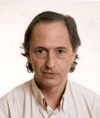March 13, 2008
 Most of the central biological functions of living cells are performed by complexes of many individual protein domains. Relative motions of these domains often play a crucial role in the biological function. We are developing an unique approach specially designed to model the structure and dynamics of large macromolecular nano-machinary.
Most of the central biological functions of living cells are performed by complexes of many individual protein domains. Relative motions of these domains often play a crucial role in the biological function. We are developing an unique approach specially designed to model the structure and dynamics of large macromolecular nano-machinary.
Over two decades ago (Levitt et al 1985) we showed that torsion angle modes capture the essential motion of protein molecules. Application of these methods to macromolecular complexes that are the basis for biological nano-machinary is not straight forward:
- Nano-machines like chaperonin consist of about 50,000 atoms (excluding hydrogen atoms) and one must use a reduced model in which a group of atoms is replaced by a single interaction center). One must also use a subset of torsion angle degrees of freedom.
- If one uses real normal modes that account correctly for the different short-range interactions between different amino acids, then the energy of the starting structure must be minimized. This minimization must reach a precise minimum where the gradient vector is zero and the second derivative matrix is positive definitive. Such minimization requires extended precision arithmetic and powerful variable metric methods but for many complexes, we are able to find minima within 3 A RMS deviation of the x-ray structures.
- The degrees of freedom of a multi-protein complex need to include the rigid body motion of the different components in the complex. Initially, we ignored these degrees of freedom and simply connected the end of one polypeptide chain to the start of the next one by a rigid link. Although this is clearly wrong, it does allow the same normal mode methods used for a single polypeptide chain to be used for any number of such chains. The resulting normal modes were often informative. This seemingly simple step actually introduces a great deal of numerical complexity in that there are now degrees of freedom that have no effect on the relative arrangement of the protein atoms. We have succeeded in overcoming these problems in simple test systems.
Michael Levitt (Stanford University, USA)


